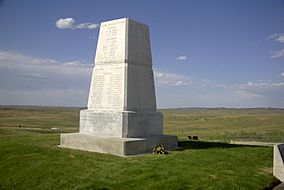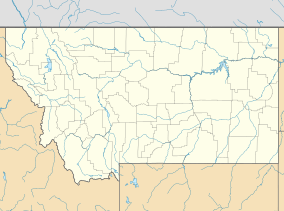Little Bighorn Battlefield National Monument facts for kids
Quick facts for kids Little Bighorn Battlefield National Monument |
|
|---|---|
|
IUCN Category III (Natural Monument)
|
|

Memorial obelisk
|
|
| Location | Big Horn County, Montana, US |
| Nearest city | Hardin, Montana |
| Area | 765.34 acres (309.72 ha) |
| Established | January 29, 1879 |
| Visitors | 332,328 (in 2016) |
| Governing body | National Park Service |
| Website | Little Bighorn Battlefield National Monument |
The Little Bighorn Battlefield National Monument is a special place in Montana, USA. It protects the area where the famous Battle of the Little Bighorn happened. This battle took place on June 25 and 26, 1876. It was fought near Crow Agency, Montana.
The monument remembers everyone who fought in this important battle. This includes George Armstrong Custer's 7th Cavalry soldiers. It also honors the combined forces of Lakota, Northern Cheyenne, and Arapaho warriors. The Custer National Cemetery, located on the battlefield, is also part of this national monument. Another related battle site, about 3 miles away, is also protected here.
Contents
History of the Battlefield Site
The land at the Little Bighorn Battlefield is quite varied. It has hills, rugged bluffs, and the Little Bighorn River. The types of plants growing there also change a lot from one area to another.
Key Dates for the Battlefield
- June 25 and 26, 1876: The famous Battle of the Little Bighorn took place here.
- 1877: General Custer, who was first buried at the site, was later moved. His body was reburied in West Point Cemetery.
- January 29, 1879: The US government first set aside this land. It became a U.S. National Cemetery. This was done to protect the graves of the 7th Cavalry soldiers.
- December 7, 1886: The site was officially named National Cemetery of Custer's Battlefield Reservation. This name was later shortened to "Custer National Cemetery."
- November 5, 1887: The Battle of Crow Agency happened about three miles north of the Custer battlefield.
- April 14, 1926: The Reno-Benteen Battlefield area was added to the protected site.
- July 1, 1940: The US United States Department of War handed over the site. The National Park Service began to manage it.
- March 22, 1946: The site was renamed "Custer Battlefield National Monument."
- October 15, 1966: The monument was listed on the National Register of Historic Places. This means it's a very important historical site.
- 1976: The American Indian Movement (AIM) protested during the 100-year anniversary. They felt the site mostly honored Custer and the US Army. They wanted the site to also recognize the Native American perspective.
- August 11, 1983: A wildfire burned away thick bushes on the site. This allowed archaeologists to explore the area more easily.
- 1984, 1985: Archaeologists dug at the site. They found many artifacts that helped tell the story of the battle.
- December 10, 1991: President George H. W. Bush signed a law. This law officially changed the name to Little Bighorn Battlefield National Monument.
Memorials and Markers
The Little Bighorn Battlefield has many memorials. These help visitors remember the people who fought there.
Early Memorials
The very first memorial was built by Captain George K. Sanderson and the 11th Infantry. They buried soldiers where they fell. In 1879, Sanderson described building a mound. It was made of wood and horse bones. Inside, they buried human bones found on the field. This mound was about 11 feet high. It was built where General Custer's body was found.
Later, in July 1881, Lieutenant Charles F. Roe and the 2nd Cavalry built the granite memorial. This memorial stands today on top of a place called Last Stand Hill. They also reburied soldiers' remains near this new memorial. They left stakes in the ground to show where soldiers had fallen. In 1890, these stakes were replaced with white marble markers.
Indian Memorial and Warrior Markers
The law that changed the monument's name in 1991 also asked for an "Indian Memorial." This memorial was to be built near Last Stand Hill.
Markers honoring the Native Americans who fought in the battle have also been added. These are placed alongside the markers for the US troops. On Memorial Day in 1999, the first red granite markers were placed. These marked where Cheyenne warriors Lame White Man and Noisy Walking fell.
The Indian Memorial was designed by John R. Collins and Alison J. Towers. It was built between 2001 and 2003. It is a low, circular wall made of sandstone. On top of the wall are bronze figures called Spirit Warriors. These were created by sculptor Colleen Cutschall.
Senator Ben Nighthorse Campbell spoke at the memorial's dedication. He said that if you visit early in the morning, you might feel the presence of the Native American people. Senator Nighthorse Campbell is a descendant of one of the Cheyenne leaders who fought Custer.
Today, red speckled granite markers for warriors dot the hillsides. They are just like the white marble markers for the soldiers. Markers have been added for the Sans Arc Lakota warrior Long Road. There is also one for the Minniconjou Lakota warrior Dog's Back Bone.
On June 25, 2003, an "unknown Lakota warrior marker" was placed. It is on Wooden Leg Hill, east of Last Stand Hill. This honors a warrior who died in the battle. His death was seen and reported by the Northern Cheyenne warrior Wooden Leg.
The battlefield is also the final resting place of Stanley Vestal. He was a historian and author who wrote about the American West.
Gallery











